Chapter 8: Designing Nomadic and Hotspot Networks
|
|
This chapter explores the key aspects of nomadic and hotspot network design. It is far from exhaustive but will convey some of the complexities and considerations that are particular to the design of such systems.
Introduction
A hotspot network supporting nomadic services will consist of remotely located low-end routers, access points (APs), wireless bridges, and so on, all connected via T1 lines to the Internet backbone. Figure 8-1 is one example of a hotspot application. Figure 8-2 shows a typical access point, and Figure 8-3 illustrates the basic configuration screen that an AP may present once installed, in particular the required Internet Protocol (IP) and Service Set Identifier (SSID) information.

Figure 8-1: Example of hotspot service configuration
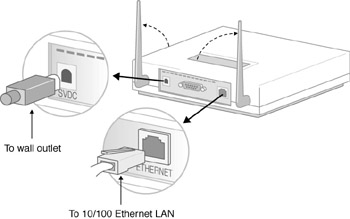
Figure 8-2: Typical AP

Figure 8-3: Typical setup screen
Logical Design Considerations
The first must-have is a cost-effective topology. The selection of hardware includes the router, the APs, and possibly wireless bridges. A terrestrial communication apparatus is required, such as T1-, DS3-, and/or Fast Ethernet (FE)/Gigabit Ethernet (GbE)-based access to the Internet. A numbering plan is needed, and security considerations have to be taken into account (such as setting up the remote authentication dial-in user server [RADIUS] server). Other service-supporting servers (such as web servers) have to be deployed.
Once the data leaves the location's hotspot router, it needs to have a legal address. This implies that the hotspot router has to both run a local Dynamic Host Configuration Protocol (DHCP) as well as a Network Address Translation (NAT) function. Notice that the AP and the users that attach to it need to be on the same IP subnet. This implies that either a 192.168.0.0 address (the Internet Address Naming Authority's [IANA] recommended unregistered numbering plan) is used for both the clients and the AP, or that both the clients and the AP are assigned legal addresses. Therefore, Local Port Address Translation (PAT) plus on-router DHCP is the way to go. In the 'Network Address Translation (NAT)' and 'Dynamic Host Configuration Protocol (DHCP)' sections, we focus on NAT and DHCP support in the infrastructure behind the hotspot radios in the various dispersed locations.
Security is important, and it covers authentication, confidentiality, and integrity. This is the reason we covered Extensible Authentication Protocol (EAP); Authentication, Authorization, and Accounting (AAA); and Wired Equivalent Privacy (WEP) in Chapter 4, 'Security Considerations for Hotspot Services.' The hotspot service designer would probably like to deploy location-specific portals that could provide advertisement revenues from businesses in the immediate vicinity. Hence, after the RADIUS server authenticates the user and determines the location of the user based on the incoming IP address from the serial interface of the remote router, interplay with a web server is needed to redirect the user's browser to the location-specific URL.
Physical Design Considerations
In this section, we highlight some key design issues as graphically as possible. Types of antennas and the field of coverage for outdoor applications are shown in Figure 8-4, which illustrates omnidirectional antennas, sector antennas, and point-to-point patch antennas. Figure 8-5 further depicts the propagation characteristics of a typical omnidirectional antenna. Table 8-1 identifies typical antennas on the market for the APs, while Table 8-2 shows typical arrangements for the laptop. See Appendix A for a more inclusive listing. Figure 8-6 shows the use of wireless bridges to interconnect dispersed hotspots.
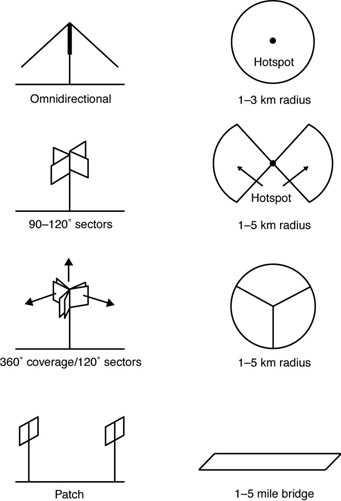
Figure 8-4: Antenna types

Figure 8-5: Example of propagation
| Type | dBi | Type | Application | Features/notes |
|---|---|---|---|---|
| Dipole 'rubber duck' | 2.2 | Omnidirectional; two short rods | Indoors | Typically comes with AP. |
| Ceiling mount | 2.2-5.2 (depends on model) | Omnidirectional; tubular | Indoors | Designed to be mounted to metal grid of suspended ceiling; aesthetically pleasing. |
| Mast mount vertical | 5.14 | Omnidirectional; tubular | Indoor or outdoor | To be clamped to a mast or pole; industrial applications; vertically polarized, must be installed perpendicular to ground. |
| Pillar mount | 5.2 | Omnidirectional; tubular; cloth-wrapped | Indoors | Aesthetically pleasing without looking like an antenna. |
| Ground plane | 5.2 | Omnidirectional; dish | Indoors | Useful for suspended ceilings. |
| Long range | 12 | Omnidirectional; tubular | Outdoors | + 3.5 and -3.5 degree beam spread. |
| Patch antenna | 3-6 (depends on model) | Directional, patch | Indoor or outdoor | Wide range. |
| Patch antenna | 8.5-16 | Directional, patch | Indoor or outdoor | Narrow beamwidth. |
| Sector antennas | 8.5 | 90 or 120 degrees sector | Outdoor | For more complex designs. |
| Yagi | 13.5 | Directional | Long Distance | 25 degrees beamwidth; 6.5 miles at 2 Mbps; 2 miles at 11 Mbps. |
| Parabolic | 21 | Directional | Long distance bridging | 12 degrees beamwidth; 25 miles at 2 Mbps; 11.5 miles at 11 Mbps. |
Table 8-2.
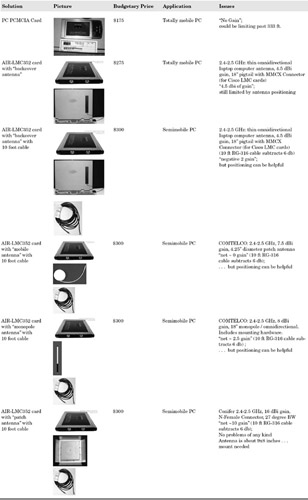

Figure 8-6: Wireless bridging using Cisco products
Figure 8-7 shows outdoor antenna coverage/designs for hotspot support. Figure 8-8 illustrates a number of possible hotspot designs along with some hotspot budgetary information. Figure 8-9 depicts an example of a prefabricated access point ready for deployment. Figure 8-10 depicts an indoor application. Figure 8-11 details indoors wireless local area network (WLAN) coverage options.

Figure 8-7: Coverage examples
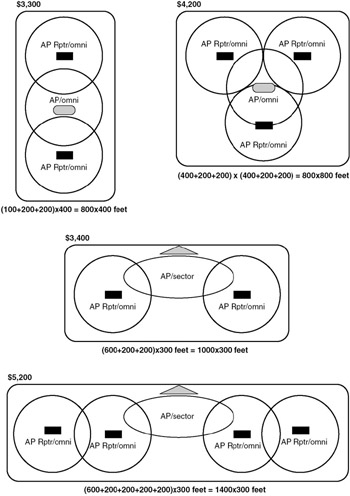
Figure 8-8: Examples of hotspot outdoor topologies

Figure 8-9: Examples of Prefabricated Hotspot node/repeater

Figure 8-10: Indoor coverage
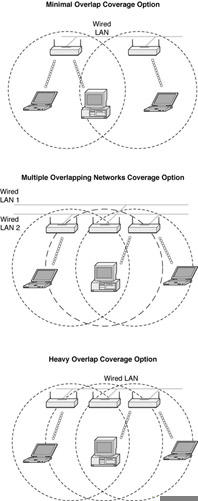
Figure 8-11: Indoors WLAN coverage options (Source: Cisco Systems)
Some key considerations for the site survey are noted in the following boxed text.
Figures 8-12 through 8-15 illustrate examples of engineering packages that may be generated, based on the requirements identified via the site survey.
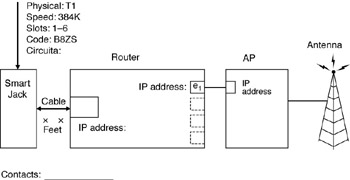
Figure 8-12: One AP configuration
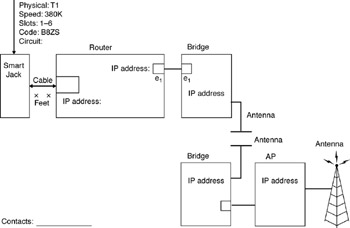
Figure 8-13: One AP with a bridge
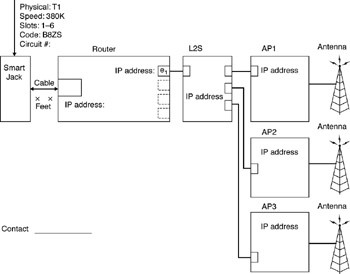
Figure 8-14: Multiple AP configuration
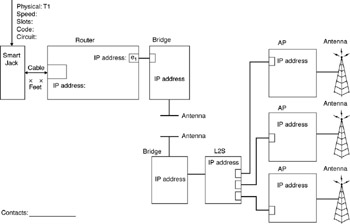
Figure 8-15: Multiple APs with a bridge
Because differences exist in component configuration, placement, and physical environment, every network application is a unique installation. Before installing multiple APs, you should perform a site survey to determine the optimum utilization of networking components and to maximize range, coverage, and network performance.
Consider the following operating and environmental conditions when performing a site survey:
-
Data rates Sensitivity and range are inversely proportional to data bit rates. The maximum radio range is achieved at the lowest workable data rate. A decrease in receiver threshold sensitivity occurs as the radio data increases.
-
Antenna type and placement Proper antenna configuration is a critical factor in maximizing radio range. As a general rule, range increases in proportion to antenna height.
-
Physical environment Clear or open areas provide better radio range than closed or filled areas. Also, the less cluttered the work environment, the greater the range.
-
Obstructions A physical obstruction such as metal shelving or a steel pillar can hinder the performance of wireless devices. Avoid locating the devices in a location where there is a metal barrier between the sending and receiving antennas.
-
Building materials Radio penetration is greatly influenced by the building material used in construction. For example, drywall construction allows a greater range than concrete blocks. Metal or steel construction is a barrier to radio signals.
Source: Cisco Systems
Figures 8-16 through 8-18 capture practical aspects of hotspot design. Figure 8-16 identifies what's needed within the Internet to support this kind of service. Figure 8-17 shows a possible carrier installation process. Finally, Figure 8-18 depicts an actual hotspot designed by me for installation in the greater New York City area.
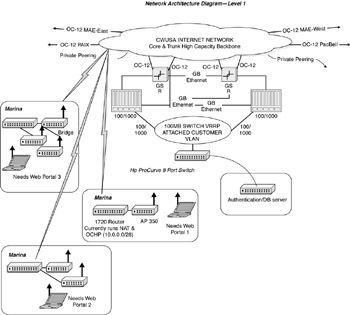
Figure 8-16: Connections back to Internet resources

Figure 8-17: Example of hotspot installation process
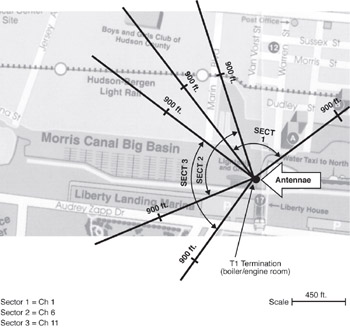
Figure 8-18: Specific topological example of hotspot installation
Will 3G Obviate the Need for WLAN Hotspot Technology?
As we transition to these topics, make a note that third generation (3G) will not replace the need for hotspot technologies based on WLANs or wireless personal area networks (WPANs). 3G systems are wide area technologies, and although they have the advantage of seamless roaming, they offer much less bandwidth (2 Mbps at most and, more likely, at the practical deployment level, 384 Kbps for a long time to come.)
A wide area technology like 3G is likely to replace WLAN technology, just as Integrated Services Digital Network (ISDN) (a wide area technology, or even Asynchronous Transfer Mode [ATM]) replaced LANs in the mid- to late 1980s. Indeed, ISDN tried to play in the LAN game; one of the first 'data' applications of ISDN was to attempt to replace IBM cluster controllers, which it totally failed to do. Eventually, incumbent carriers tried to deploy CO-LAN, again based on ISDN, but it also failed. And even with its high capacity of OC3, ATM could never catch up with FE, GbE, and 10GbE in the LAN.
The point is that a wide area network (WAN) technology has a hard time competing with a LAN technology when it attempts to provide a LAN service. Beyond that, there is the increased cost of a WAN/3G system compared with WLANs/WPANs that comes with paydowns on the licenses paid for the spectrum and with the major nationwide tower and transmission apparatus that has to be built.
As an example, the author has deployed hotspot technology in dozens of locations around the United States using 802.11b and 802.11a technologies. The service covers the areas for a radius of 1 to 2 miles or more, depending on antenna design. This service is priced as little as $40 a month (annual subscription) for unlimited use. Although this does not support a boater's access to the Internet while at sea, satellite-based systems (such as those based on INMARSAT) can cost between $2 to $8 per minute of usage, which is quite astronomical. In fact, the two systems are not even seen as being competitive. A 100-foot yacht may use the satellite-based system while at sea (with hardware costs of around $10,000 compared to $100 for an IEEE 802.11b network interface card [NIC], and with an asymmetric link of much less uplink bandwidth and perhaps 256 Kbps on the downlink on a shared Very Small Aperture Terminal [VSAT] system), why would its owner spend that amount while sitting comfortably in the marina surfing the net for business or pleasure, when a subscription to a hotspot service can provide connectivity for $0.10 per hour? Work is afoot to provide roaming capabilities between picocells, microcells, macrocells, and worldcells, enabling the use of LAN-based WLAN technology while in a hotspot or business office and then, perhaps, shifting to a 3G system of much lower bandwidth and higher cost while traveling between hotspots.
|
|
EAN: N/A
Pages: 88